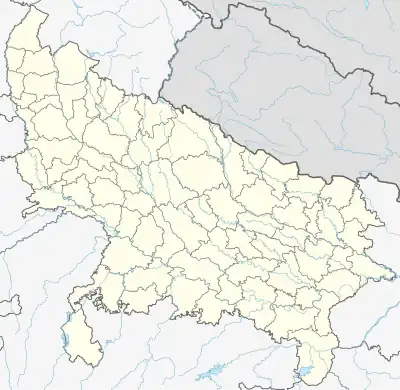Jarwal | |
|---|---|
Town | |
 Jarwal Location in Uttar Pradesh, India | |
| Coordinates: 27°10′N 81°33′E / 27.17°N 81.55°E | |
| Country | |
| State | Uttar Pradesh |
| District | Bahraich |
| Elevation | 117 m (384 ft) |
| Population (2011) | |
| • Total | 19,289 |
| Languages | |
| • Official | Hindi, Urdu |
| Time zone | UTC+5:30 (IST) |
| Vehicle registration | UP-40 |
Jarwal is a town and a nagar panchayat in Bahraich district in the Indian state of Uttar Pradesh. It has an average elevation of 117 metres (383 feet). This place is 20 km away from historical Lodheshwar Mahadev Mandir located in Mahadeva Ram Nagar, that is well described in old mythological stories.
Demographics
As of 2011 census of India[1] Jarwal had a population of 19289. Males constitute 52.54% of the population and females 47.46%. Jarwal has an average literacy rate of 49.83%, lower than the state's rate of 67.68%. Male literacy is 55.09%, and female literacy is 43.94%. In Jarwal, 17.53% of the population is under 6 years of age.
Jarwal Road railway station is the nearest railway track and it is 9 km from Jarwal Kasba.
History
The Sayyids of Jarwal, along with those of Kintoor and Zaidpur, were well known Taluqadars (feudal lords) of Awadh province.[2]
The Sayyids of Jarwal were descended from one Abu Talib, who was originally from Iran. During Genghis Khan's invasion, Abu Talib fled with his family, first to Khorasan and then to Lahore. In 1286, his son Aziz ud-Din went to Delhi, and his own son Ala ud-Din eventually settled in Bado Sarai, in Barabanki district. Ala ud-Din had two sons: Jalal ud-Din and Jamal ud-Din. Jalal ud-Din incurred the ire of the Delhi sultan Ghiyath ud-Din Tughluq, who had him executed. Ghiyath ud-Din later tried to make amends to Jamal ud-Din by granting him 25,000 bighas of land, revenue-free, in Barhauli, on the south bank of the Gogra, and another 25,000 in Jarauli on the north bank.[3]
While Jamal ud-Din had no trouble establishing himself in Barhauli, he faced stiff resistance from Raja Chhatarsal, the Bhar ruler of Jarauli, and died without taking control of the fort of Jarauli. His son, Sayyid Zakariyya, finally gained control of the fort in 1340, probably because of military support from Muhammad bin Tughluq, who is known to have been in the Bahraich area during that year.[3]
In 1800 the Jarwal Sayyids, some of them Shi‘is, displaced the Ansari Shaykhs and came to hold 276 out of 365 villages in the parganah, although their holdings thereafter declined rapidly to (a still formidable) 76 villages in 1877.[4][5][6][7] Khateeb-ul-Iman Maulana Syed Muzaffar Husain Rizvi Tahir Jarwali (1932-Dec 1987) a Shia religious leader was one of the prominent Jarwali Sayyid and celebrated preacher of late 20th century (1970s & 80s), he was also General Secretary of All India Shia Conference for some time.[8][9][10]
References
- ↑ "Basic Population Figures of India, States, Districts, Sub-District and Town (Without Ward)". Census of India. 2011. Retrieved 15 June 2022.
- ↑ King Wajid Ali Shah of Awadh, Volume 1 by Mirza Ali Azhar, Royal Book Co., 1982
- 1 2 Benett, William Charles (1877). Gazetteer of the Province of Oudh, Volume 1. Lucknow: Oudh Government Press. pp. 115–16. Retrieved 1 August 2020.
- ↑ Gazetteer of the Province of Oudh 1:141; 2:83, 99-100.
- ↑ The North-Western Provinces of India: Their History, Ethnology, and Administration, Asian Educational Services, 01-Jan-1998
- ↑ Muslims in Avadh by Mirza Azhar Ali, page 71
- ↑ The imperial gazetteer of India by W.W. Hunter, 1881
- ↑ Toby M. Howarth (2005). The Twelver Shîʻa as a Muslim Minority in India: Pulpit of Tears. Psychology Press. ISBN 9780415362344.
- ↑ The Light, Volumes 22-23. Bilal Muslim Mission of Tanzania. 1988. p. 3.
- ↑ Nadeem Hasnain; Sheikh Abrar Husain (1988). Shias and Shia Islam in India: a study in society and culture. Harnam Publications. p. 6. ISBN 9788185247007.